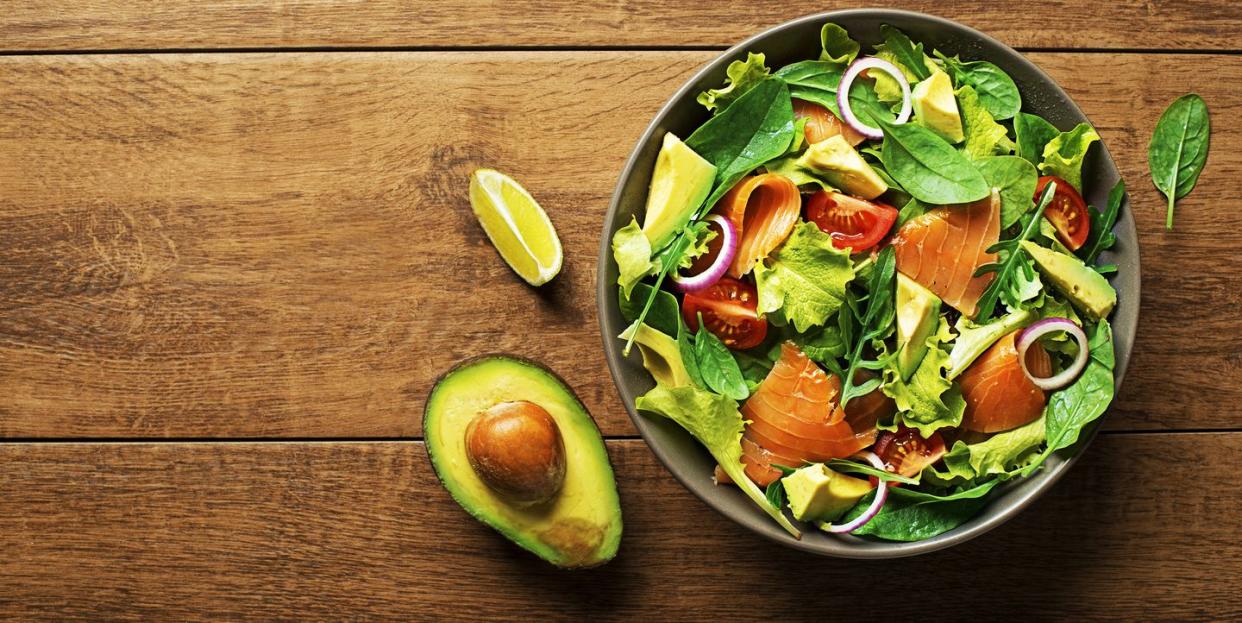The Satiating Diet Is Like Keto, But Safer and More Effective

When you think about all those times you yo-yo dieted, one common theme probably comes to mind: You weren't satisfied with your meals. The truth is, low-calorie diets that don't have a good balance of protein, carbs, and healthy fats will set you up for failure. Enter the satiating diet. Unlike restrictive diets, like the keto diet, Paleo, and Whole30, the satiating diet has the perfect combination of three essential macronutrients.
"Think of protein, carbs, and fat as three legs on a stool," says Bonnie Taub-Dix, RDN, creator of BetterThanDieting.com, and author of Read It Before You Eat It - Taking You from Label to Table. "They support each other and make you feel balanced, like you have a bit of everything."
What is the satiating diet, exactly?
Known for being a hybrid of the keto diet and the Mediterranean diet, the satiating diet includes foods that are high in protein, such as fish; high fiber, like whole grains; and high in fruits and vegetables, according to nutrition researchers at Scientific American. The satiating diet also contains healthy fats from avocados, nuts, and even dairy like yogurt. Consuming these foods help decrease hunger, reduce body fat, lower blood sugar, improve blood pressure, and boost metabolism.
The satiating diet also encourages dieters to get some capsaicin—the active component in chili peppers that makes them spicy. Studies have shown that capsaicin can contribute to weight loss by increasing brown fat in the body, which helps burn energy and fat.
The other major component of following the satiating diet is that there are zero food restrictions, so you'll never feel deprived and are able to better manage your cravings.
"When you cut out food groups in your diet, you'll obviously lose weight because you're literally depriving your body of something," Taub-Dix says. "But a long-term, sustainable weight loss plan doesn't involve eliminating food groups at all."
Can the satiating diet help you lose weight?
Yes, according to results from a 2017 study. In it, 34 obese men started following the satiating diet, which included 20 to 25 percent protein, for 16 weeks. Another group of 35 obese men followed a standard diet with 10 to 15 percent protein. The men who followed the satiating diet lost a significant amount of weight and body fat and experienced more fullness after meals compared to the men who followed the standard diet.
Bottom line: Following the satiating diet can help you lose weight because it involves eating foods that are extremely satisfying and eliminate cravings. It has all the important ingredients of losing weight successfully and keeping the weight off longterm. But Taub-Dix points out that it doesn't take into account the mental and psychological factors around weight loss. "You need to know your own body and how much you should be eating so you can feel satiated," she says. "Knowing when you're hungry and trying to stop eating when you're full are all individual needs–and no diet can tell you that."
In fact, the best "diet" for weight loss isn't a diet but a lifestyle. "You should be able to sit down and eat a meal with your whole family and not have to feel like you can't eat what everyone else is eating," Taub Dix adds.
While many people might prefer to follow a diet that tells them what to eat and what to avoid, these types of diets aren't sustainable because once you drop the pounds, you need to be making the right food choices on your own.
"The diets that have lists for enjoying and avoiding aren't built for leading a healthy lifestyle. People who follow diets with more liberal guidelines succeed the most because they eliminate the stress of losing weight," Taub-Dix says.
How to start following the satiating diet
You can start following the satiating diet by incorporating more lean protein, whole grains, fruits and vegetables, and healthy fats into your meals. Choose leaner cuts of meat, chicken, and pork, and go for fish, especially fatty fish like salmon, tuna, and mackerel. Be sure to add whole grains, such as quinoa, farro, brown rice, and oats, with every meal to help stabilize your blood sugar, and good fats from avocado, nut butter, and extra-virgin olive oil. There's no counting or measuring when it comes to following a satiating diet, but that's the beauty of it.
If a diet book would help make following the satiating diet easier, check out Prevention's Fill Your Plate, Lose the Weight: 70+ Delicious Meals That Keep You Full. This 21-day weight loss plan designed for women over 40 is filled with delicious recipes, easy-to-follow meal plans, grocery lists, and mindful eating tips to help you reach your goals.
Stay updated on the latest science-backed health, fitness, and nutrition news by signing up for the Prevention.com newsletter here. For added fun, follow us on Instagram.
You Might Also Like

